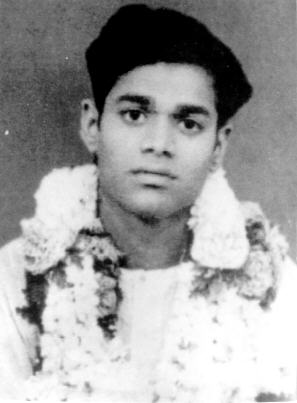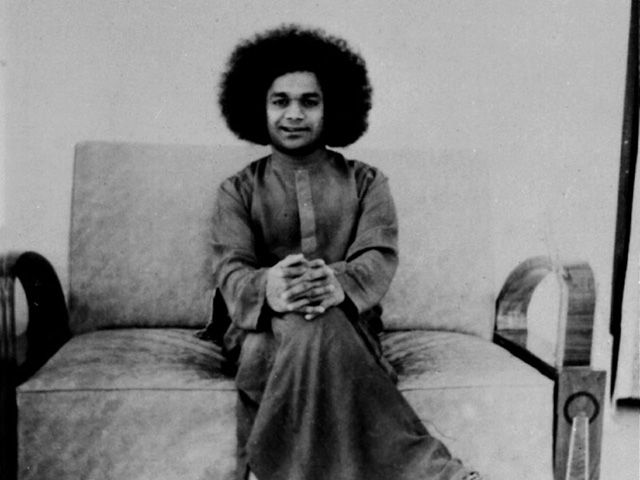| |
Sai Baba's Birth and Childhood

Sai Baba was born in Puttaparthi,
a remote village in southern India, on November 23, 1926, and
given the family name of Satyanarayana Raju. Stories of the family
and villagers tell of "miracles" which began to occur shortly
before his birth. Musical instruments in the family home, for
example, are said to have played by themselves. Another unusual
incident is said to have occurred shortly after the baby was born.
Someone noticed movement under his blankets on the floor and he
was quickly snatched up. Discovered beneath the blankets was a
deadly cobra, which for some reason had not harmed the baby. (The
cobra, coincidentally or not, is the symbol of Shiva, of Hinduism's
holy trinity.)
From early childhood it was
apparent that young Satya was quite different from his playmates.
Although his family ate meat, he himself was a natural vegetarian,
who abhorred the thought of killing animals. He was extremely
helpful to all in the village, doing work unselfishly, frequently
bringing beggars home to be fed by his parents—though they often
scolded him for what they felt to be unwarranted generosity on his
part. He was called "guru" by his playmates, leading them in
devotional songs before school and fascinating and amusing them by
taking candy and playthings from an apparently empty bag.
Then a mysterious incident
occurred when Satyanarayana was thirteen. One day while playing
outside, he leaped into the air with a shriek, holding his bare
foot. His family feared he had been stung by a scorpion and would
not survive. But he slept that night without apparent pain or
sickness. Then twenty-four hours later, he fell unconscious and
remained so for a day. When he awoke, his behavior was strange,
alternating between periods of unconsciousness and what appeared
to be trance-like states. He began chanting and quoting long
Sanskrit passages of poetry and philosophy far beyond the scope of
his formal education.
At times he became stiff and
appeared to those around him to leave his body, then described
distant places which his parents said he had never visited and
people whom to their knowledge he had never known. He laughed and
cried, explained complicated religious doctrines. Could he be
possessed by evil spirits?
Satya endured a period of torture
as his parents took him to exorcists throughout the countryside.
One famous and feared exorcist, to whom the boy's demon had become
a personal challenge, shaved Satya's head and cut three crosses
into his skull, then poured caustic material into the wound and
into his eyes until they were swollen almost shut. Finally, his
parents could stand no more of this ordeal and called a stop to it,
though their son had apparently not been cured.
Baba subsequently stated that he
was demonstrating at this time that he is beyond pleasure and pain,
beyond duality. He has disclosed that there was in fact no actual
scorpion sting: No such bite could create a Satya Sai Baba, and if
it could, then scorpions should he objects of the highest
veneration and worship.
Two months after the supposed
sting, in May 1940, Satya's father saw a crowd gathering around
his son. He appeared to be manifesting candy and fruit out of thin
air, and many people were falling to the ground, calling him an
incarnation of God. Confused and frustrated by his son's strange
behavior and now by this display of sleight-of-hand or, worse,
black magic, Satya's father picked up a stick and approached
threateningly. "Who are you... who are you?" he demanded angrily.
In a calm but firm voice, the boy
announced: I am Sai Baba. Then he proceeded to relate how he had
chosen this particular family for his incarnation in answer to the
prayers of a devout ancestral sage. He was, he said, the
reincarnation of a little-known but much respected Moslem holy
man, named Sai Baba of Shirdi, who dressed like a Moslem but wore
ash on his forehead like a Hindu. The original Sai Baba had died
eight years before Satya was born—the length of time he had
reportedly told his devotees would elapse before his reincarnation.
Naturally, it was difficult for
many in the village to accept this boy, unusual and charming
though he was, as the actual reincarnation of a man regarded by
his followers as a saint. Young Satyanarayana was beginning to be
quite a mystery indeed. Then a couple of months later, on Thursday—Guru
Day in India—a group of questioning villagers approached him,
pleading, "Show us a sign!"
With a quick and unexpected
gesture, Satya threw a bunch of jasmine flowers onto the floor.
There, it is reported, they clearly spelled out—in Telugu script,
the language of the village—"Sai Baba."
Soon afterwards, Satya Sai Baba
told his family that he belonged with them no longer, that his
devotees were calling and that he had to leave. He left school in
October of his thirteenth year and began to gather followers
around him. They grew in number until it became necessary to
establish an ashram, where many could live with their guru, and
where those seeking his guidance could meet with him. The
construction of Prasanthi Nilayam (Abode of Eternal Peace)
continues even to the present in an attempt to accommodate Sai
Baba's swelling number of devotees. Here and at Brindavan, his
summer residence, Baba has received millions of people from India
and around the world.
From the book: "Sai Baba, The
Holy Man and the Psychiatrist", by Dr. Samuel Sandweiss, M.D. (pp.
94-95)

|
